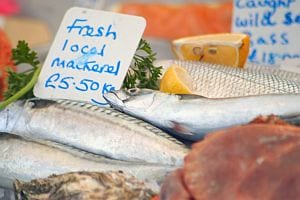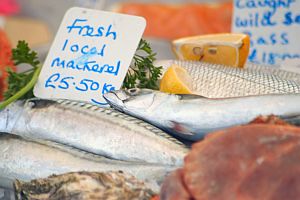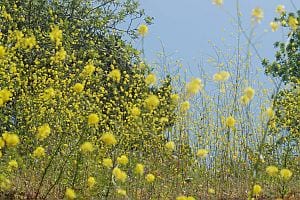statFor some women, it's about making an elegantement at special events or being a couple…

One Fish, Two Fish, Good Fish, Bad Fish? Making the Right Seafood Choices for You and Your Family
 There’s no question about it — seafood has become complicated. Issues ranging from genetically modified organisms, potentially toxic herbicides and pesticides and long-term soil depletion to growth hormones, antibiotics and the living conditions of farm animals make it more important than ever (and more difficult) to shop thoughtfully for groceries. Pay for organic? Eat seasonal? Buy local? Go vegetarian or vegan? It’s a lot to consider. But all this complexity doesn’t end with the choices we make about domesticated plants and animals. And it doesn’t stop at the water’s edge either.
There’s no question about it — seafood has become complicated. Issues ranging from genetically modified organisms, potentially toxic herbicides and pesticides and long-term soil depletion to growth hormones, antibiotics and the living conditions of farm animals make it more important than ever (and more difficult) to shop thoughtfully for groceries. Pay for organic? Eat seasonal? Buy local? Go vegetarian or vegan? It’s a lot to consider. But all this complexity doesn’t end with the choices we make about domesticated plants and animals. And it doesn’t stop at the water’s edge either.
Over the past decade, we’ve seen more and more articles in the media about the many health benefits that come with eating fish on a regular basis. At the same time, we’ve seen other articles (sometimes in the same newspapers and magazines) about the growing health threat of contaminants like mercury and other heavy metals that are finding their way into many important fish populations. Then there global concerns about widespread over-fishing and ecologically dangerous fishing practices… How do we separate fact from fiction? Once we do that, how do we make decisions that are consistent with our values and priorities?
All of these issues are real. There are many nutritional benefits to eating fish, and there are types of fish that are high in contaminants, and there are varieties of fish you might want to avoid for ecological reasons. In this short article we can’t possibly do justice to the whole topic, but we can give you a few tips about which fish varieties are both good and bad for you, which may taste good but are bad for you, and which are sustainable and thus better to include in “green” diet plans.
Good Fish
According to lists compiled by Seafood Watch, an environmental program run by the Monterey Bay Aquarium, the following fish (1) are high in healthy omega-3 fats, (2) contain low levels of contaminants, and (3) come from sustainable fisheries or fishing grounds:
- Albacore tuna (from the northwestern U.S. or British Columbia). Although many varieties of ocean tuna have high mercury levels, these tuna get a “Green Rating” if they were pole- or troll-caught because they are smaller, usually weighing less than 20 pounds. This means that they haven’t lived as long as larger ocean tuna, and thus have not had time to absorb as much mercury and other contaminants.
- Salmon (wild-caught in Alaska). These salmon come from well-maintained and sustainable fisheries, where both breeding and fishing are controlled. As a result, they are more nutritious in terms of omega-3 fats per ounce, and contain fewer contaminants than other types of salmon.
- Oysters (farm-raised). These shellfish are not only good for you (being high in omega-3 and iron), they’re good for the environment in which they’re raised, because they feed off of algae and nutrients in the water while keeping it free of contaminants.
- Sardines (wild-caught in the Pacific Ocean). These tiny fish are emerging on several nutritionists’ lists of “super foods” because they have more omega-3 nutrition per ounce than salmon, tuna, and most other seafood species. They also reproduce quickly, so they are not endangered as a species.
- Rainbow trout (farm-raised). Although most lake trout have high contaminant levels, in the U.S., most rainbow trout are farmed in freshwater ponds and are both nutritious and safe.
Bad Fish
The fish on this list, however, should probably be on your “avoid” list, because they have been shown to contain risky levels of contaminants:
- Bluefin tuna. This is one of the most endangered fish species, as identified by the World Wildlife Fund. But it is also one of the most dangerous, containing such high levels of mercury and PCBs that the Environment Defense Fund recommends not eating it at all.
- Chilean sea bass. Known for its taste, this species is slow-growing, and has been very over-fished in its native Antarctic waters. They have high mercury levels, and the fishing methods used are known to damage the ocean floor.
- Grouper. This fish can live to the age of 40 and reproduces slowly, facts which place it firmly on a number of endangered lists. Its long life also gives it time to absorb more contaminants than other fish varieties.
- Orange roughy. Another long-lived fish (they can live 100 years or more) that is both vulnerable to overfishing and that has high levels of mercury.
- Salmon (farmed). Almost all salmon sold in the U.S. and labeled as “Atlantic salmon” is raised in crowded fish pens and farms that are so full of parasites and diseases that they actually imperil wild salmon in the same area. The farmed salmon are fed antibiotics to combat the diseases found in their pens, and contain high enough PCB levels to have received a “thumbs-down” rating from Seafood Watch. So it really does pay to read the label, and to be sure where your fish comes from before you serve it to your family.




